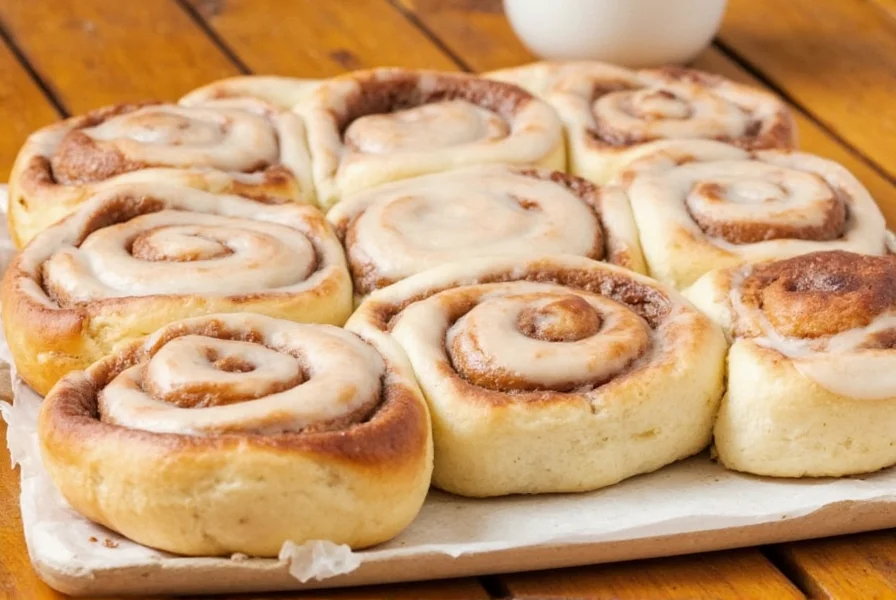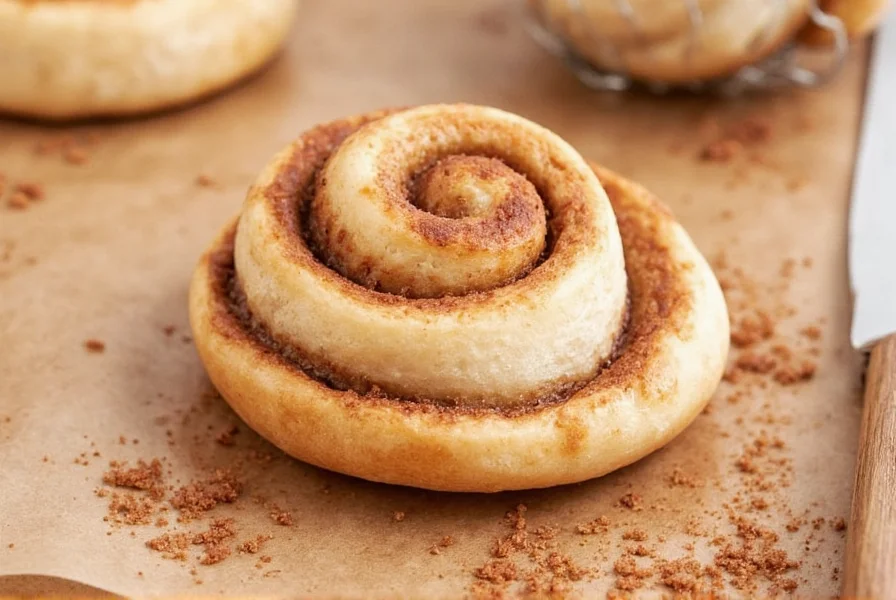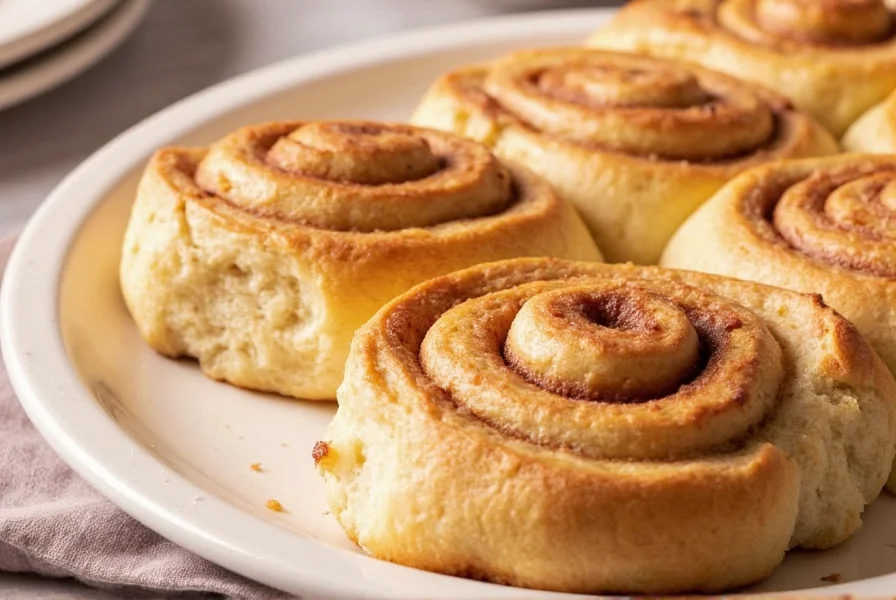Here's a proven cinnamon rolls recipe that yields soft, fluffy homemade sweet rolls with perfectly balanced cinnamon filling and creamy icing. This from-scratch recipe requires 3 hours total time (including rising), uses standard yeast dough ingredients, and produces 12 generous rolls. Key success factors: proper yeast activation (110°F liquid), adequate rising time (1-2 hours until doubled), and baking at 350°F for 20-25 minutes until golden brown.
There's nothing quite like the aroma of homemade cinnamon rolls filling your kitchen on a weekend morning. While store-bought options exist, nothing compares to the tender texture and rich flavor of classic cinnamon rolls made from scratch. This recipe has been perfected through years of baking and teaching others, focusing on reliable techniques that work consistently whether you're a beginner or experienced baker.
Why This Cinnamon Rolls Recipe Works
The secret to perfectly soft and fluffy cinnamon roll dough lies in the balance of ingredients and proper technique. Unlike many recipes that use excessive sugar in the dough (which can inhibit yeast activity), this version maintains the ideal environment for yeast to thrive while still delivering sweetness. The dough contains just enough fat from butter and eggs to create tenderness without weighing down the rolls.
Professional bakers know that cinnamon roll baking temperature is critical - too hot and the rolls brown before cooking through, too cool and they become dense. Our tested 350°F (175°C) temperature ensures even baking with that perfect golden crust while maintaining a light interior.
Ingredient Breakdown: More Than Just a List
Understanding why each ingredient matters helps you become a better baker and troubleshoot if needed:
| Ingredient | Function | Substitution Notes |
|---|---|---|
| Active dry yeast (2¼ tsp) | Leavening agent for rise | Can substitute instant yeast (use 25% less) |
| Warm milk (110°F/43°C) | Activates yeast, adds richness | Non-dairy milk works but may affect texture |
| Bread flour (3½ cups) | Higher protein for structure | All-purpose works but rolls may be less chewy |
| Unsalted butter (⅓ cup) | Tenderness and flavor | Margarine creates greasy texture |
The cinnamon roll filling ratio is equally important - too little and the rolls lack flavor, too much and the filling leaks out during baking. Our tested ½ cup brown sugar to 2 tbsp cinnamon creates the ideal sweet-spicy balance without compromising the dough structure.

Step-by-Step Instructions for Success
Follow these detailed steps for easy cinnamon rolls recipe from scratch that delivers professional results:
- Activate the yeast: Combine warm milk (110°F), 1 tbsp sugar, and yeast. Wait 5-10 minutes until foamy. If it doesn't foam, start over with fresh yeast.
- Make the dough: Mix yeast mixture with melted butter, eggs, remaining sugar, salt, and 2 cups flour. Gradually add remaining flour until dough pulls away from bowl.
- Knead: On floured surface, knead 5-7 minutes until smooth and elastic. Properly kneaded dough should pass the "windowpane test" (stretch a small piece thin enough to see light through without tearing).
- First rise: Place in greased bowl, cover, and let rise in warm place until doubled (1-2 hours). Pro tip: Don't rush this step - proper rise equals light rolls.
- Prepare filling: Mix brown sugar and cinnamon. Roll dough into 16x12 inch rectangle. Spread softened butter evenly, then sprinkle filling mixture.
- Roll and cut: Roll tightly from long side, pinch seam. Cut into 12 equal pieces using dental floss (prevents squishing).
- Second rise: Place in greased 9x13 pan, cover, rise until puffy (45-60 minutes).
- Bake: 350°F for 20-25 minutes until golden brown. Don't overbake - they continue cooking slightly out of oven.
- Icing: While warm, spread cream cheese icing made with 4 oz cream cheese, ¼ cup butter, 1½ cups powdered sugar, and 1 tsp vanilla.
Common Cinnamon Roll Problems and Solutions
Even experienced bakers encounter issues. Here's how to fix the most common cinnamon roll dough troubleshooting problems:
- Dense rolls: Usually caused by insufficient rising time, too much flour, or old yeast. Measure flour properly (spoon and level, don't scoop) and verify yeast activity.
- Filling leaking out: Too much butter in filling or rolling too loosely. Use softened (not melted) butter and roll tightly with even pressure.
- Burnt bottoms: Oven too hot or dark pan. Use light-colored pan and check temperature with oven thermometer.
- Not rising properly: Verify liquid temperature (110°F is ideal), and ensure rising environment is warm (80-85°F) but not hot.

Variations for Different Dietary Needs
This best homemade cinnamon rolls recipe adapts well to various preferences:
- Vegan version: Substitute dairy milk with almond milk, use vegan butter, and replace eggs with flax eggs (1 tbsp ground flax + 3 tbsp water per egg)
- Gluten-free: Use quality gluten-free flour blend with xanthan gum. Expect slightly denser texture but still delicious
- Less sweet: Reduce filling sugar to ⅓ cup and icing sugar to 1 cup for a more subtle sweetness
- Flavor twists: Add orange zest to dough, use apple pie spice instead of plain cinnamon, or mix in chopped pecans with the filling
Storage and Reheating for Perfect Results
Proper storage maintains that fresh-baked cinnamon roll texture longer:
- Room temperature: Store covered for up to 2 days. Reheat individual rolls 10-15 seconds in microwave
- Refrigerator: Keeps up to 1 week. Bring to room temperature before reheating
- Freezer: Freeze unbaked rolls on parchment-lined baking sheet, then transfer to freezer bags. Bake from frozen, adding 5-8 minutes to cinnamon roll baking time
Frequently Asked Questions
How do I know when cinnamon roll dough has risen enough?
Properly risen dough will be approximately double in size and when gently pressed with a fingertip, the indentation will remain rather than springing back immediately. For the first rise, this typically takes 1-2 hours at room temperature (75-80°F).
Can I prepare cinnamon rolls ahead of time?
Yes, you can prepare cinnamon rolls up to two days in advance. After shaping and placing in the pan, cover tightly and refrigerate. On baking day, remove from refrigerator 1-2 hours before baking to allow proper rising. Alternatively, freeze shaped rolls and bake from frozen, adding 5-8 minutes to baking time.
Why did my cinnamon rolls come out dense?
Dense cinnamon rolls are usually caused by insufficient rising time, too much flour in the dough, or old/dead yeast. Measure flour properly by spooning into measuring cup and leveling off (don't scoop). Verify yeast activity by testing in warm liquid with sugar before making dough. Allow adequate rising time until dough is truly doubled in size.
What's the ideal baking temperature for cinnamon rolls?
The ideal baking temperature for cinnamon rolls is 350°F (175°C). This temperature allows the rolls to cook through properly without browning too quickly. Bake for 20-25 minutes until golden brown. Using an oven thermometer is recommended as many ovens have inaccurate temperature settings.
How can I prevent my cinnamon roll filling from leaking out?
To prevent filling leakage, use softened (not melted) butter when spreading on the dough, and roll the dough tightly with even pressure. Don't overfill with too much sugar mixture, and make sure to pinch the seam well after rolling. Chilling the rolled log for 15 minutes before cutting can also help maintain structure.











 浙公网安备
33010002000092号
浙公网安备
33010002000092号 浙B2-20120091-4
浙B2-20120091-4